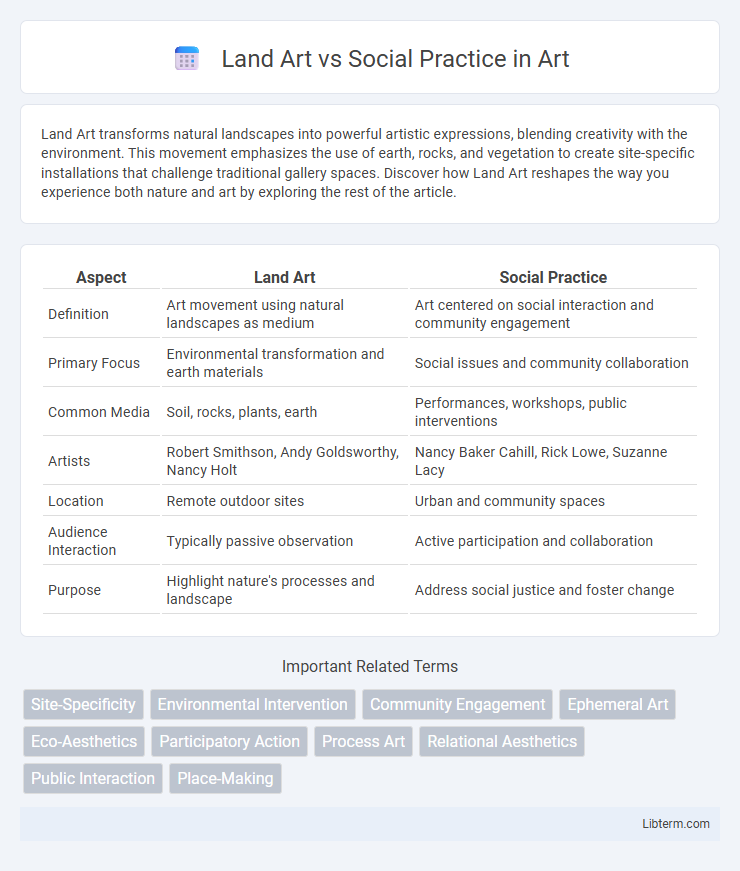Land Art transforms natural landscapes into powerful artistic expressions, blending creativity with the environment. This movement emphasizes the use of earth, rocks, and vegetation to create site-specific installations that challenge traditional gallery spaces. Discover how Land Art reshapes the way you experience both nature and art by exploring the rest of the article.
Table of Comparison
| Aspect | Land Art | Social Practice |
|---|---|---|
| Definition | Art movement using natural landscapes as medium | Art centered on social interaction and community engagement |
| Primary Focus | Environmental transformation and earth materials | Social issues and community collaboration |
| Common Media | Soil, rocks, plants, earth | Performances, workshops, public interventions |
| Artists | Robert Smithson, Andy Goldsworthy, Nancy Holt | Nancy Baker Cahill, Rick Lowe, Suzanne Lacy |
| Location | Remote outdoor sites | Urban and community spaces |
| Audience Interaction | Typically passive observation | Active participation and collaboration |
| Purpose | Highlight nature's processes and landscape | Address social justice and foster change |
Introduction to Land Art and Social Practice
Land Art emerged in the late 1960s as an environmental art movement involving large-scale interventions in natural landscapes, using earth, rocks, and organic materials to create site-specific works that challenge traditional gallery spaces. Social Practice centers on community engagement and participatory art, emphasizing collaboration with audiences to address social issues and promote cultural dialogue. Both movements redefine the role of the artist by expanding artistic contexts beyond conventional boundaries, linking environment and society through creative expression.
Historical Origins and Evolution
Land Art emerged in the late 1960s as a radical movement where artists like Robert Smithson and Nancy Holt used natural landscapes to create large-scale environmental sculptures, emphasizing site specificity and ecological awareness. Social Practice, evolving prominently in the 1990s, centers on community engagement and social issues, with artists such as Suzanne Lacy and Rick Lowe fostering participatory projects that prioritize interaction and activism over traditional art objects. The historical evolution shows Land Art's focus on isolation and environment gradually shifting toward Social Practice's emphasis on collaboration, social intervention, and collective experience.
Key Artists and Influencers
Land Art pioneers like Robert Smithson, known for Spiral Jetty, and Michael Heizer, creator of Double Negative, transformed natural landscapes into monumental earthworks emphasizing site-specific environmental interaction. Social Practice artists such as Suzanne Lacy and Rick Lowe prioritize community engagement and social activism, using collaborative projects to address social issues and foster public participation. The contrast lies in Land Art's focus on physical site intervention, while Social Practice centers on human relationships and social change as primary mediums.
Core Philosophies and Intentions
Land Art emphasizes the intrinsic connection between natural landscapes and creative expression, highlighting environmental transformation and the temporality of materials. Social Practice centers on community engagement, aiming to foster social change and collaborative participation through art as a tool for dialogue and activism. Both disciplines challenge traditional art boundaries but diverge in focusing on ecological interaction versus socio-political impact.
Materials and Methods
Land Art primarily utilizes natural materials such as earth, rocks, and vegetation, employing site-specific methods that transform landscapes through excavation, sculpting, and arranging organic elements. Social Practice art prioritizes human interaction and community engagement, using participatory methods, collaborative projects, and ephemeral materials like paper, fabric, or digital media to foster social dialogue and cultural exchange. Each approach reflects distinct methodologies: Land Art emphasizes environmental integration and material permanence, while Social Practice centers on process, social context, and relational aesthetics.
Engagement with Environment and Community
Land Art emphasizes direct interaction with natural landscapes, creating large-scale environmental sculptures that transform and highlight ecological features while fostering a deep connection to the physical environment. Social Practice centers on community engagement and collaborative processes, using art as a tool to address social issues, encourage participation, and build relationships within diverse populations. Both approaches prioritize interaction, but Land Art focuses on environmental context and physical space, whereas Social Practice prioritizes social dynamics and communal involvement.
Aesthetic vs. Social Impact
Land Art emphasizes aesthetic transformation of natural landscapes through large-scale, site-specific works that engage viewers visually and spatially. Social Practice prioritizes community involvement and social interaction, aiming to foster social change and collective experiences rather than focusing solely on visual appeal. The tension between aesthetic impact and social engagement defines the distinction, where Land Art centers on artistic form and environment, while Social Practice centers on audience participation and social outcomes.
Critical Reception and Controversies
Land Art often faces critical scrutiny for its environmental impacts and permanence in natural landscapes, sparking debates over ecological ethics and artistic intervention. Social Practice art encounters controversy regarding its effectiveness in fostering community engagement and accusations of performative activism or superficial social impact. Both genres challenge traditional art spaces, provoking ongoing discourse about art's role in environmental stewardship and social change.
Notable Projects and Case Studies
Notable Land Art projects include Robert Smithson's "Spiral Jetty," which transforms natural landscapes into monumental earthworks, emphasizing environmental interaction and geological time. In Social Practice, projects like Rick Lowe's "Project Row Houses" in Houston focus on community revitalization through collaborative art, integrating social change with cultural identity. These case studies highlight Land Art's emphasis on environmental aesthetics and Social Practice's commitment to socio-political engagement and grassroots development.
Future Directions and Emerging Trends
Land Art increasingly incorporates eco-conscious materials and technology to address climate change, emphasizing site-specific sustainability and regeneration. Social Practice evolves through digital platforms and community-driven projects that foster inclusivity and social justice, integrating interactive and participatory methods. Future trends reveal a convergence of these fields, leveraging augmented reality and environmental activism to create immersive, impactful artistic experiences.
Land Art Infographic

 libterm.com
libterm.com